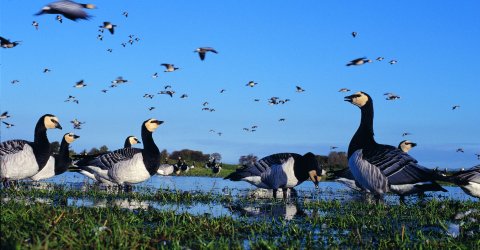
On the Migration of Water and the Flow of Birds in the Upper Solway Ramsar Site, UK
The Upper Solway: a vast intertidal zone of flats and marshes which unites South West Scotland to North West England and into which rivers—the Nith, the Annan, the Eden and the Esk among them—describe their sinuous channels in sand and mud in a last run towards the Solway Firth, defining treacherous territory for humans. The nineteenth-century writer Sir Walter Scott proclaimed: ‘He that dreams on the bed of the Solway, may wake up in the next world.’ The incoming tide is fearsome in its speed, unforgiving in its rise.
The Solway is a place that is forever betwixt and between, the ebbing and flowing of water in these estuarine lands mimicking the to-and-fro of history between Scotland and England, erasing and remaking the border between them that is, in any case, just an idea: something cultural rather than ecological. This space of come and go, of rise and fall, is ruled by the imperatives of flow.
On the Scottish side lies the Caerlaverock National Nature Reserve and, within that, a 570 ha wetland centre run ably by the Wildfowl and Wetlands Trust and established by Sir Peter Scott. In the winter here, the light is porcelain. The sky some days is almost white, ready to shatter in rain. The site is also a vast overwintering ground for a huge variety of wetland bird species, and these represent another way in which these Solway lands and waters refuse fixed definition.
Two of the most charismatic winter visitors are the Arctic Svalbard population of the Barnacle Goose (Branta leucopsis) which can number over 30,000 in the Solway area in winter, and high numbers of Whooper Swans (Cygnus cygnus) migrating in from Iceland. The Barnacle Goose is called, in Norwegian, Hvitkinggås, and I wonder at what point in its journey of almost 2,000 miles from its Arctic breeding grounds it stops being Hvitkinggås and becomes Barnacle, when its sheds its Norwegian status as the white-cheeked goose and instead inhabits a name generated by a folkloric assumption which pre-dates our knowledge of migration: that the bird grew from goose barnacles, and somehow became avian after beginning life as an arthropod. The change from Hvitkinggås to Barnacle seems somehow a similar kind of metamorphosis, and therefore fitting that it should spend its winters in safe roosts in a landscape of water that is forever shifting appearance while simultaneously connecting inland hydrology to ocean currents. The Barnacle Goose shares this fluid identity and the ability to reach out and connect. The same is true of the Whooper Swan: Álft (pronounced owlt) in Icelandic, which arrives in the UK to an onomatopoeic name for one of its calls. The common names of both these birds shift at some arbitrary point (while their taxonomic names remain constant) in a way that denies their status as visitors and instead welcomes them home in a familiar way. The Solway connects at once to Svalbard and to Iceland, drawing in during autumn and gesturing out in spring.
At the WWT Reserve at Caerlaverock this is marked by the raising of Norwegian and Icelandic flags as these specialist wetland birds arrive in September and October- a gesture of solidarity. The flags are lowered again as they depart for their breeding grounds in Spring. As I write this, the pole at Caerlaverock is flying another standard: the Senegalese flag, to welcome back the Osprey (Pandion haliaetus)—or, in the Wolof language, Bolou mbeul—that it is hoped will nest nearby until close to the time when the tide turns, and the incoming winter birds start to flow.
By David Borthwick, Lecturer (Interdisciplinary Studies), University of Glasgow
With thanks to Richard Smyth and Sarah Thomas for assistance with translations.
Image by kind permission of WWT